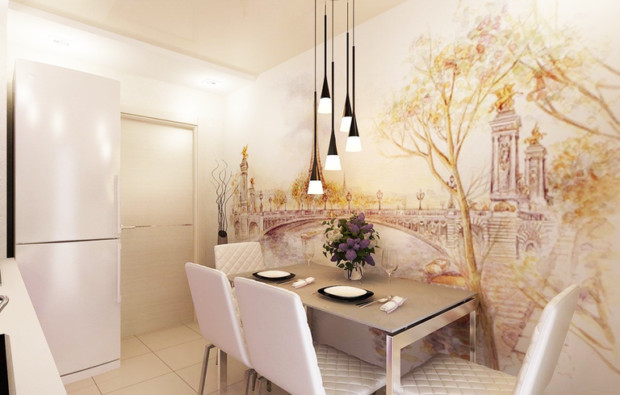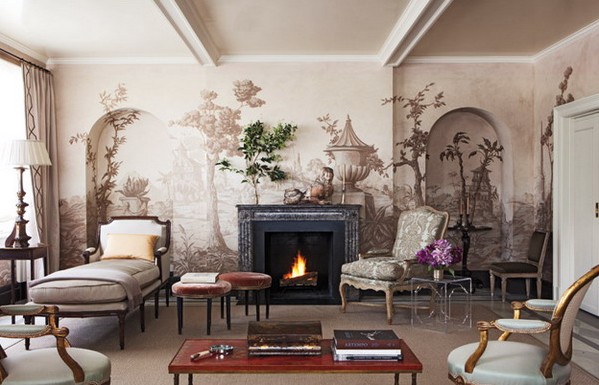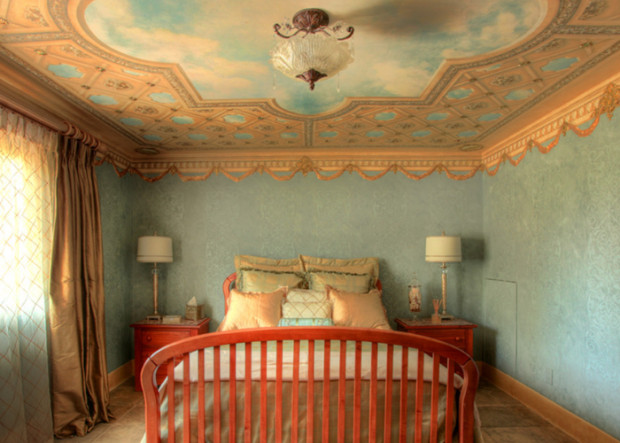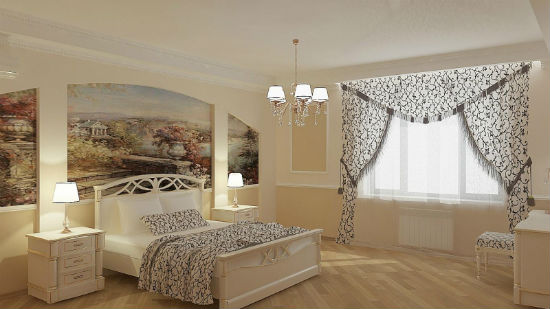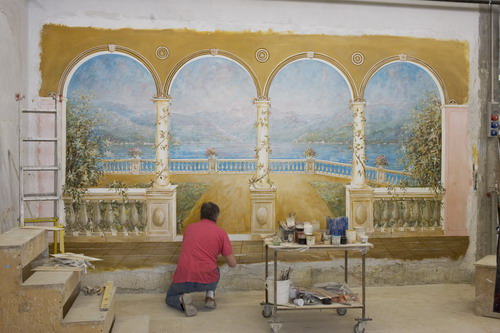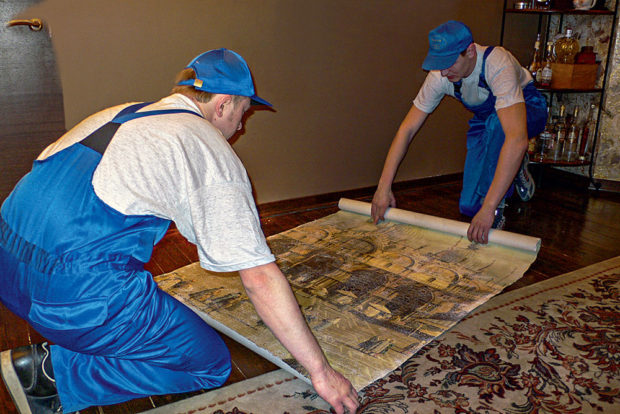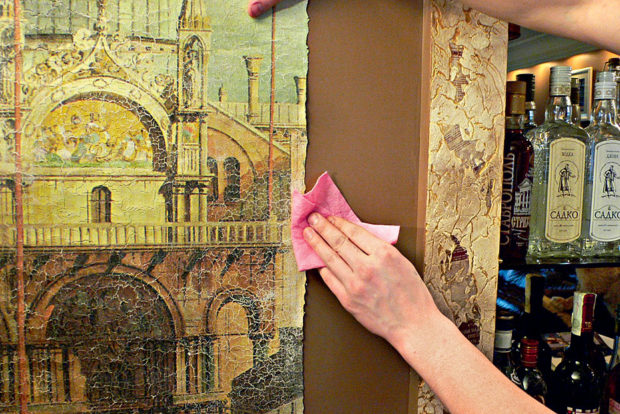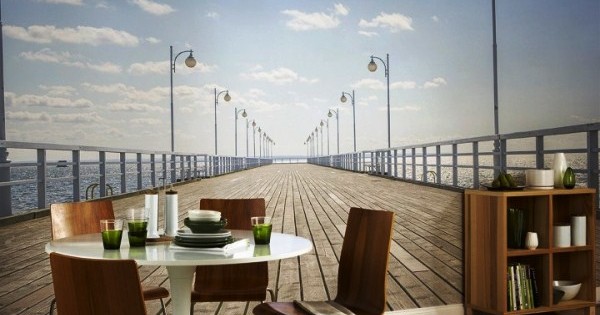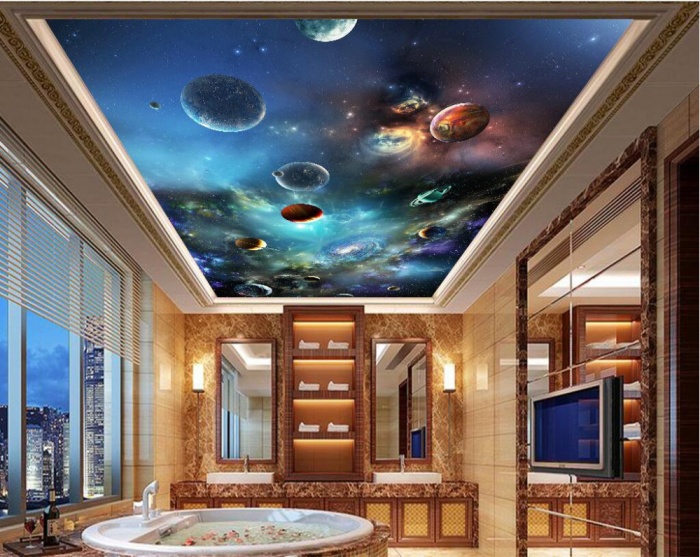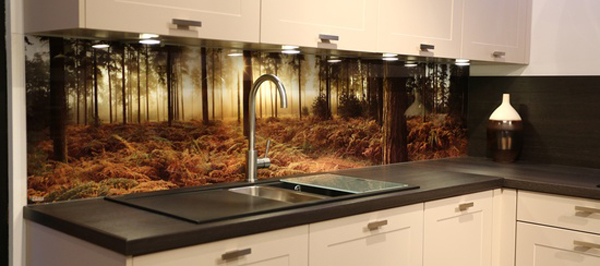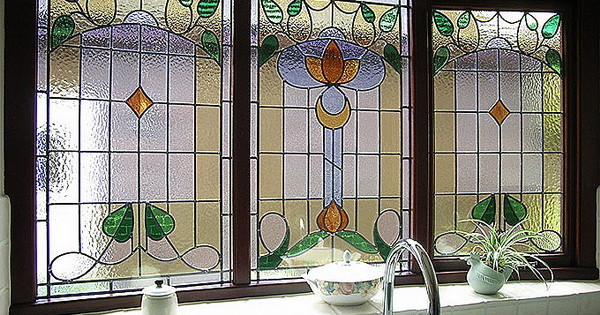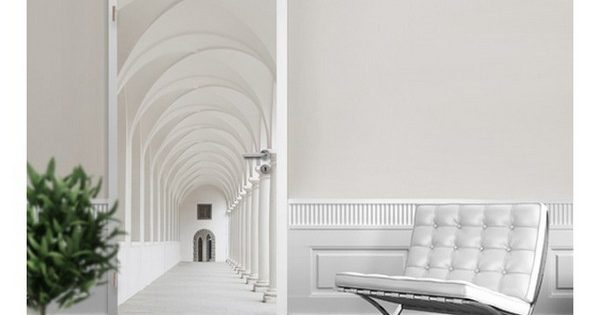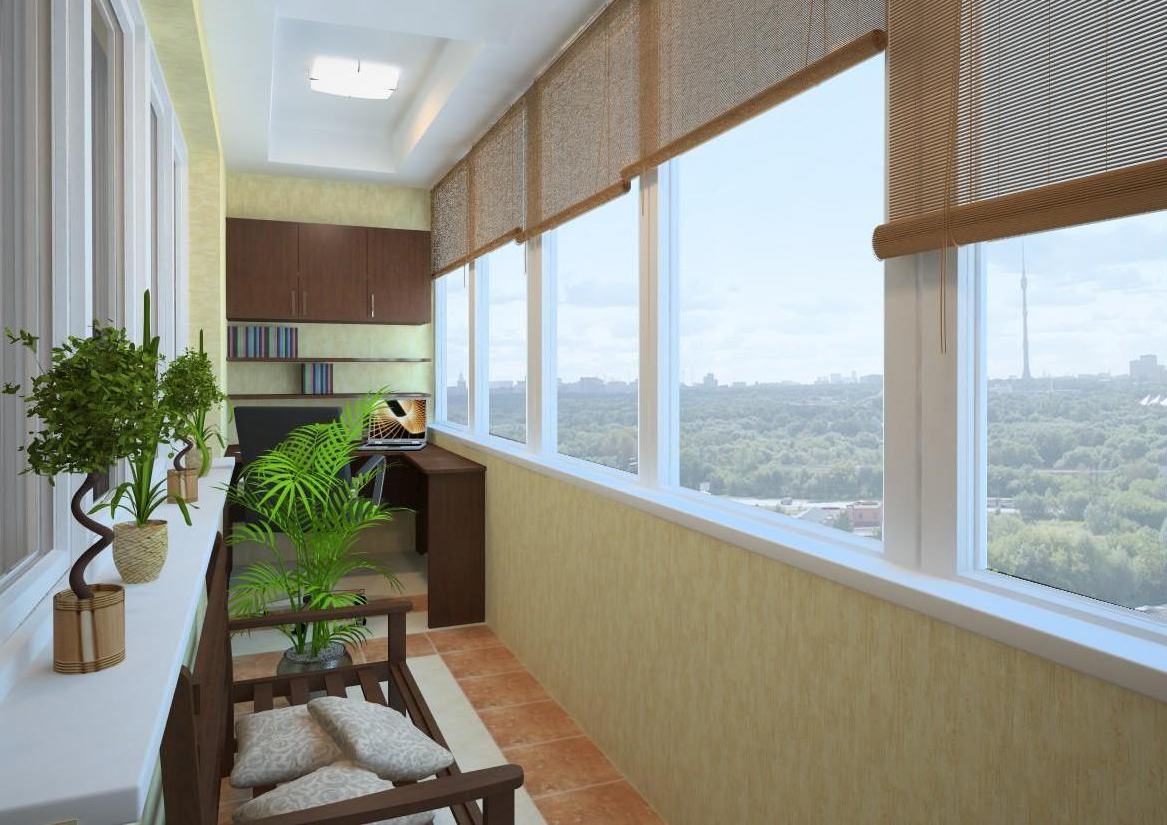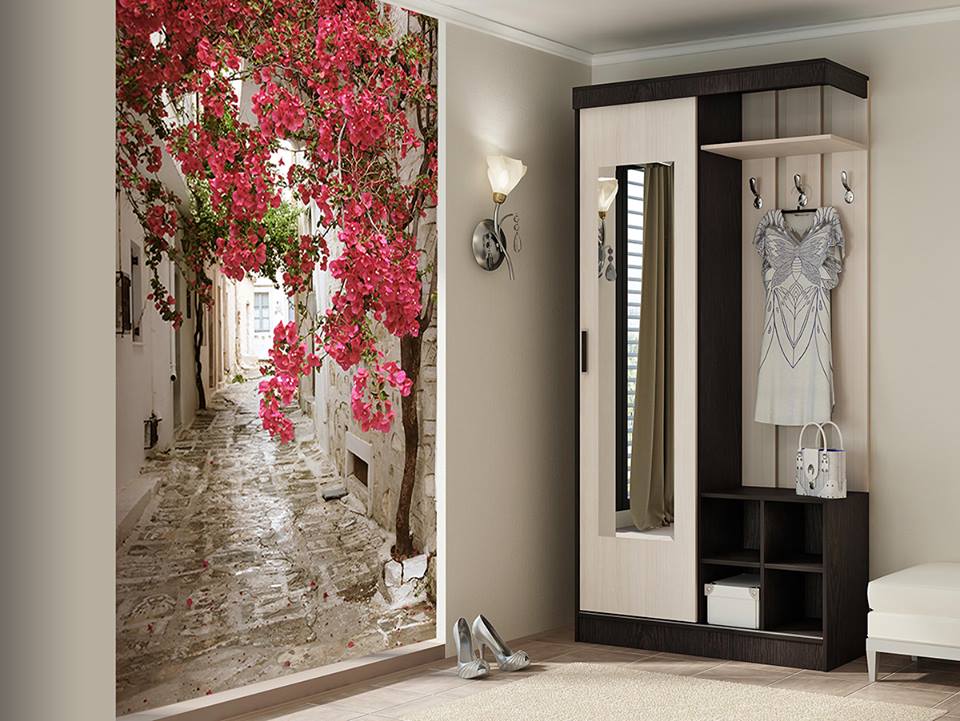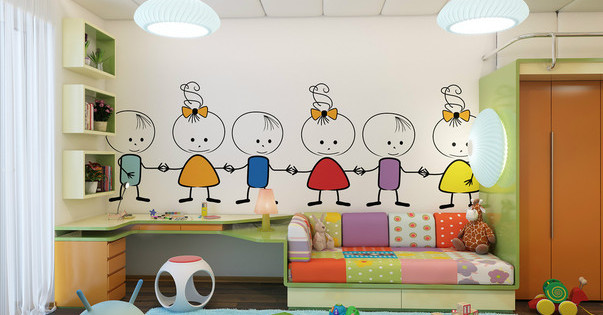Murals in the interior: 8 tips for decorating walls with murals + photos
Murals are strongly associated with palace interiors and ancient temples. This is a luxurious decoration that was created manually by craftsmen. Thanks to modern technology, exquisite decor can appear on the walls or on the ceiling of any city apartment or country house. Moreover, it is not always expensive, and it takes not so much time to complete the design. The main thing is to determine the plot and placement. How to use murals in the interior to make the home refined, but not tasteless? What technologies create modern murals? How to apply a mural with your own hands? We hasten to share all the secrets and tips with you, and let a lot of photos serve as inspiration.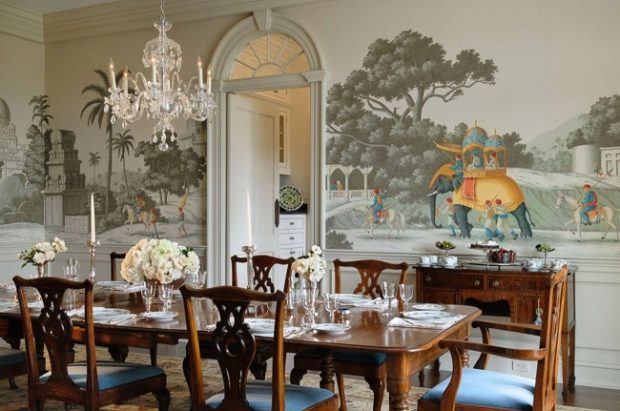
Classic and modern murals
The first frescoes date back to the 2nd century BC. Wall painting of this kind was widespread in ancient Greece and ancient Rome, as well as in ancient Russia. The word "fresco" itself is of Italian origin. Fresco means fresh. This translation is The secret to fresco technique
Original murals were applied to fresh, damp plaster. It was not that plaster, which today is decorated with apartments - a special mixture of sand and slaked lime was used. Paints were prepared from natural pigments, diluted with water. A drawing was created on freshly applied plaster. When dried, the paints literally fused with the base, providing the mural with phenomenal durability.
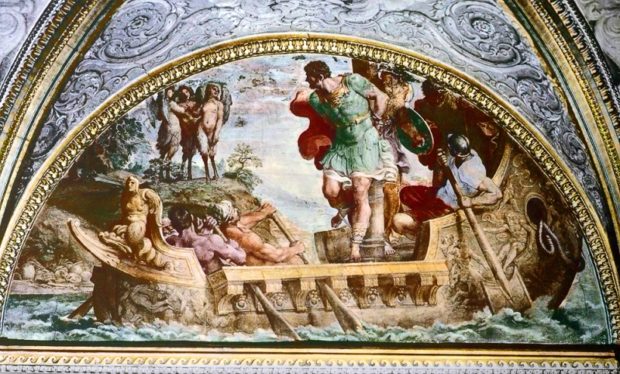
Sample of an old fresco
The lime dried quickly, so the craftsmen applied it in fragments. It was impossible to correct the drawing. If something went wrong, you had to completely remove the dried lime and start all over again. Those ancient frescoes that we see when visiting temples, cathedrals and palace complexes are the result of the long and painstaking work of professional masters.
There is also a paint technique dry plaster ("A secco"). The finished image is inferior to the classic frescoes only in terms of durability.
Today found many other ways to create murals. Yes, and under the mural itself now they mean any wall and ceiling painting with paintsapplied by brush, airbrush or otherwise. According to the technology of creation, these are not the well-known classic murals, but these modernized panels look very similar to ancient masterpieces.
To decorate a room with a fresco, it is not at all necessary to be a painter. You also don’t have to hire a master - there are a lot of fresco imitations on sale. They are carried out according to different technologies, the drawing can be any. The price varies depending on the method of creation: there are extremely affordable options, there are more expensive analogues.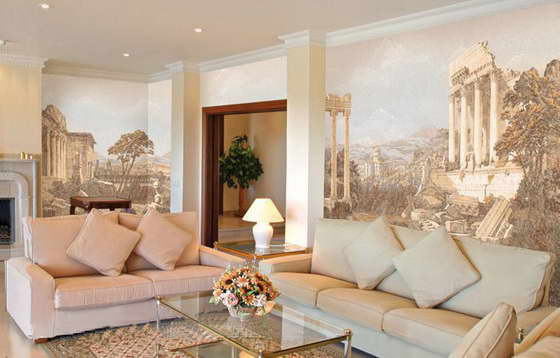
Frescoes now adorn not only plastered walls. Similar images successfully fit practically in any style of interior, perform a decorative function, can visually expand the space and zone it.
Modern murals are made primarily of natural materials. The technologies used protect the image from the harmful effects of moisture, ultraviolet radiation and temperature extremes. Some designers even use murals when decorating house facades.
The main types of frescoes
Classic technology creating murals to decorate housing is rarely used. Instead, it is usually used ready-made murals, which are quite simple to mount, but look almost the same as their ancient counterpart.
Mural on flexible plaster
This method is most close to the classic option of creating frescoes. Instead of a mixture of lime and sand, special plaster compositions are used as the basis. They introduce components that allow the plaster to remain moist and elastic for longer, which gives the master more convenience in creating a picture. The plaster is reinforced with a mounting grid.
The result is a handmade fresco. The result depends on the talent of the master, but still a unique picture comes out. Such murals are expensive, they are not created very quickly, but externally they are as close as possible to the original samples.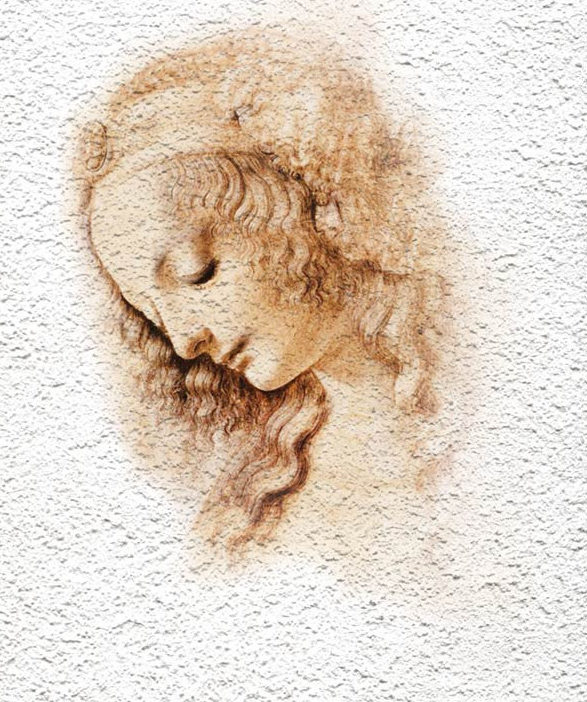
Fresco on canvas
Each such mural is individual. Master uses canvas primers it, applies plaster, and then creates a pattern and ages it, creating cracks and scuffs. The work uses only natural paints. Such murals are quite fragile, afraid of detergents. For additional protection against external influences, the fresco is covered with wax.
Work on creating these frescoes is labor intensive. Each image is unique. Products are quite expensive, relate to elite segment. The mural can be framed or not. The product without a frame can be gently glued to the wall with wallpaper gluegetting a spectacular imitation of a real mural.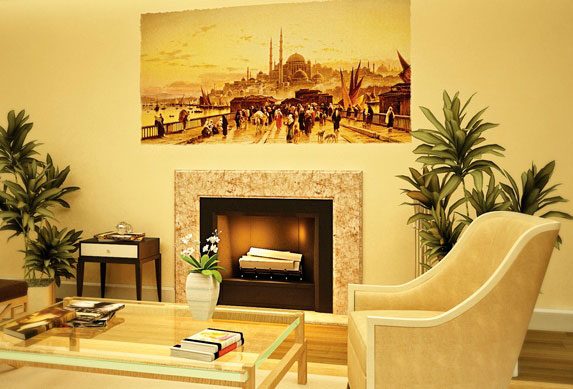
Stucco fresco
Another worthy imitation of these ancient frescoes. The drawing is applied to a layer of elastic plaster, which is reinforced with a mounting grid. The image is not created by hand, but looks very much like manual work. The finished factory mural is mounted on the wall or ceiling with glue, the edges are processed stuccodue to which the effect is achieved, as if the drawing was applied directly to the wall.
A similar imitation of murals is quite popular today. Its main advantages include low cost and excellent performance. The product is not afraid of sunlight and moisture, does not crack, as it is reinforced with a mesh. Moreover, the texture is preserved, as in old frescoes.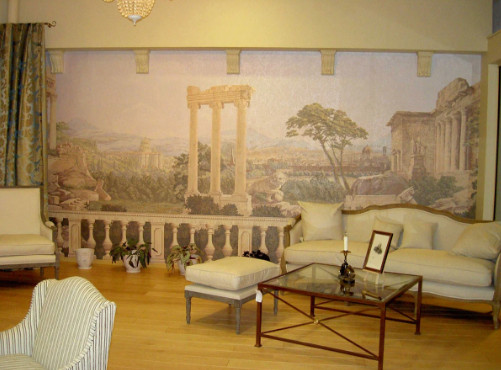
Non-woven mural
These products boast affordable prices. As the name suggests, the dominant role here is non-woven. A thin layer of plaster is applied to the base, and the pattern is created, as a rule, using a printer for photo wallpaper. Then the image is artificially aged, if necessary. Thin cracks form a whole grid over the entire fresco, giving the image the effect of antiquity. However, it often dispenses with a similar option. Also, the mural can be covered with special impregnations.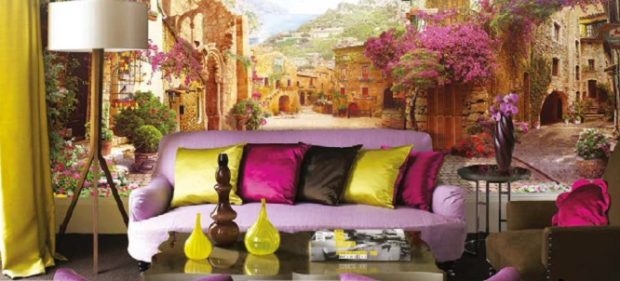
Wallpaper murals are attached to the surface with glue for non-woven wallpaper. Small bumps on the base are allowed - they will hide under the cover. Even an untrained master will cope with the installation of such frescoes. The product can decorate the entire wall or part of it. The joints between the individual canvases will be invisible, but in urban apartments and one cloth is often enough.
Murals on non-woven are stamped in large quantities. There is no need to talk about an individual drawing, but products are inexpensive and allow you to breathe into the home a special mood.
Self-adhesive mural
Self-adhesive frescoes belong to the budget segment, reminiscent of the installation principle photo wallpaper. Some designers generally consider them a kind of photo wallpaper, since the external similarity with them is much greater than the similarity with classical murals.
The product is based on a self-adhesive cloth. The reverse side is treated with a special compound. It is enough to remove the protective film to stick the mural on the wall - no additional solutions are needed. A special composition with river sand is applied to the front side. Using digital technology, he creates the necessary drawing on it. It is impossible to age it, but there is a small relief.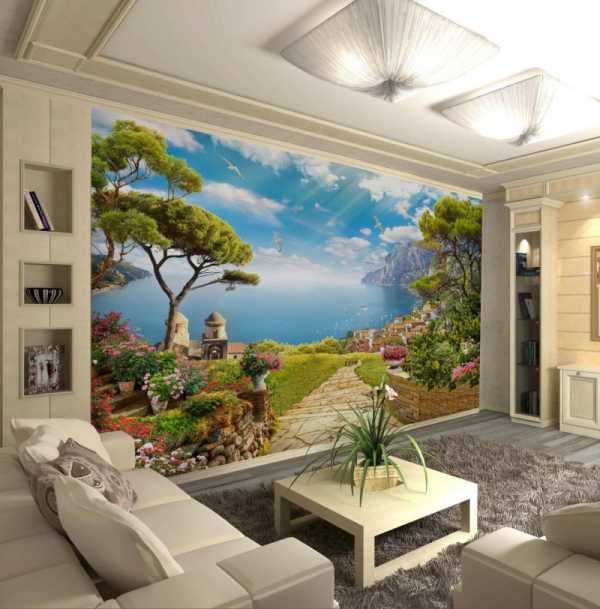
Among the main advantages of such frescoes, we note low cost, ease of installation and a huge selection of drawings. On the other hand, the product is quite thin, the layer of plaster with sand is minimal, so the surface of the wall should be perfect - all cracks and pits will be noticeable, and such a relief will only spoil the overall picture.
Hard Mural
The plaster is applied on a wooden or ceramic base, less often - plastic. The pattern is usually created using acrylic paints. If the aging effect is needed, all chips and scuffs are created on the basis. A great advantage of this method is the ability to make chips along the edges. It seems that the fresco was carved from an old building and transferred to your apartment.
The frescoes are quite heavy, so covering them with a large area will not work. It is not possible to find a product larger than 3 * 1.5 m, but even quite compact work is decent. As a rule, frescoes of this kind are mounted on the walls according to the principle of paintings, but some prefer to stick them to the surface. Someone manages to frame the product. It all depends on what goals you plan to achieve.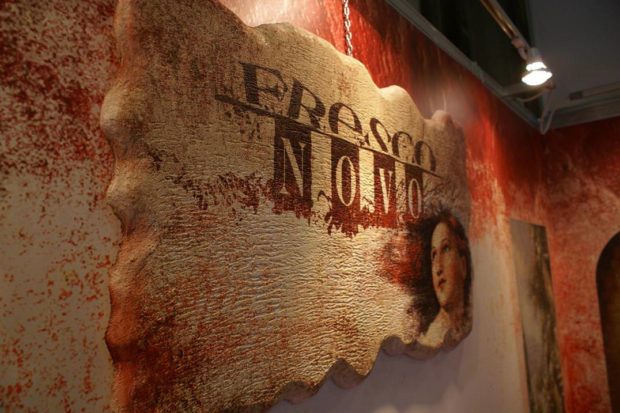
Design and image
Anything can be depicted on the fresco. The choice for those wishing to use such a decor opens huge. In order not to get confused, focus on the style and color scheme of the room. Also consider the functions that are assigned to the mural: just decoration, accent detail, zoning or also a way to compensate for some flaws (low ceilings, small area, lack of lighting, etc.).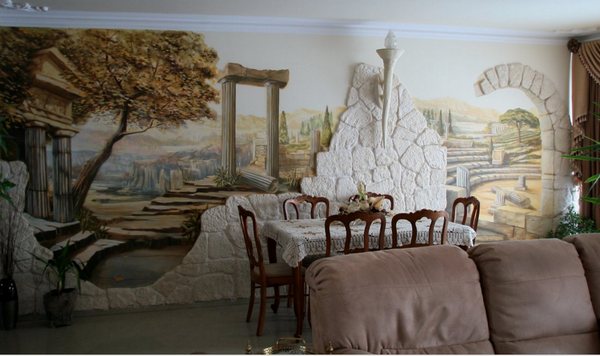
Murals are especially popular. the following topics:
- reproductions of famous paintings - an option for a classic interior. The faces of saints are also sometimes used;
- an antique or medieval plot will also complement the classic interior and will convey the true character of fresco art;
- patterns and abstract drawings - an option for modern interiors. They can decorate the whole wall;
- sea, forest, mountain and field landscapes make the apartment more spacious, suitable for a number of interiors;
- floral ornaments fill the apartment with warmth, especially suitable for a classic interior and provence;
- urban landscapes, whether it is narrow winding European streets with cozy cafes, or skyscrapers of a megalopolis, just like natural landscapes, expand the space of the room. Depending on which atmosphere you want to create, comfortable or driving, choose the appropriate pattern;
- imitation of the view from the balcony or the window works great for a visual increase in space;
- if you want to decorate the ceiling with a fresco, then you can choose images of the sky, birds or angels.

Place and role in the interior
Murals in the interior usually include:
- on the walls. This is the most popular. decor method. The image can be of any size and shape, occupy a small part of the wall or even the entire wall;

- on the ceiling. Such placement of the fresco is suitable only for apartments with high ceilings, otherwise the image can strongly press. In classic interiors, frescoes are in perfect harmony with stucco;

- for decorating various architectural details, eg, nichesprotrusions columns. With the right image selection you can achieve incredible effects. For example, when depicting in the niche the wide-open doors of the balcony overlooking the sea, you can create the feeling that the apartment is, in fact, located on the shore.

Of course, the main role of frescoes in the interior is decor. They bring a certain mood to the room, set the character, reflect the tastes of the owner. However, similar images can take on other functions:
- zoning. Only a part of the wall can be decorated with a fresco, separating one zone from another. Let's say the walls are combined living room kitchen plastered. One of the walls in the living room can be decorated with a fresco. And then certainly no walls will be needed to draw a line between different zones;
- compensation for room defects. Choosing a suitable image of the necessary color scheme and size, you can change the perception of the room, for example, visually enlarge it, make it lighter or higher.
For low rooms You can pick up a pattern with characteristic vertical lines. This can be an image of a forest, tall houses, stems of flowers, etc. Such murals work in much the same way as striped wallpaper. Visually raise the ceilings it is possible using images of stone vaults, heaven, bridges. Owners of low dwellings can go for another trick. Let the fresco from the wall smoothly transition to the ceiling. This method works flawlessly.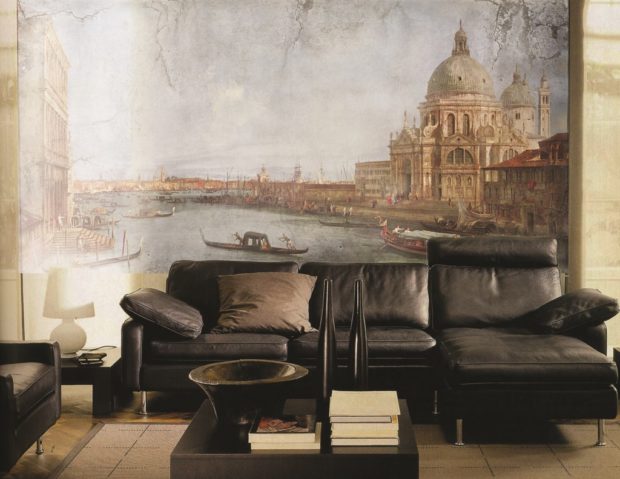
If the room cannot boast the desired area, it is better to use light-colored murals. Images with perspective are perfect: forest paths, city streets, landscapes, etc. To create a harmonious space, the image on the mural must be supported by interior items. For small spaces bright murals and large-sized images are not suitable.
For rooms with insufficient natural light Choose murals of warm colors. Yellow and orange tones work best.
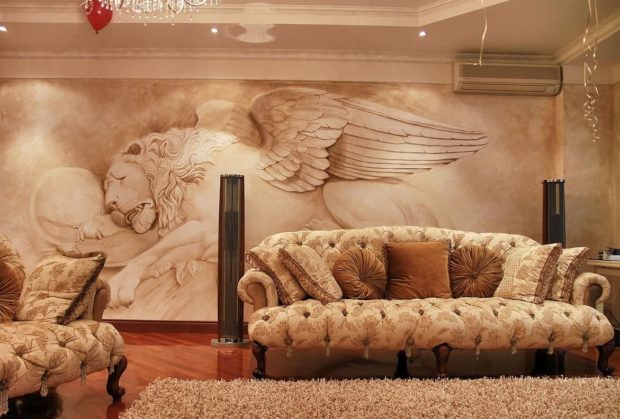
The combination of frescoes with decoration materials
The classic way involves applying stucco frescoes. Harmonious of all, such images really look exactly on the plastered surface. Both relief plaster and smooth venetian. It is desirable that the tonality of the mural and the surface coincide.
In modern realities, frescoes are applied, or rather, mounted on other surfaces. They look good on matte paint, stone, brick and wallpaper. If you chose wallpaper as the basis, then take plain canvas. The abundance of drawings and ornaments will distract from the main thing, scatter attention and, frankly, hint at the bad taste of the owners.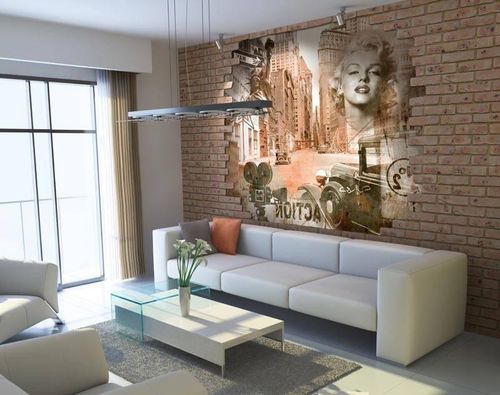
Fresco and interior style
The fresco can be called almost universal decoration. Of course, such a decor looks best in classic interiors, but with the right choice of pattern and color scheme you can successfully enter the mural in any style:
- in minimalism A fresco with an abstract pattern, an image of some laconic object, with stains or a transition of colors will look great. No complicated drawings, antique scenes and landscapes;
- great murals look in style provence. In this case, images of lavender fields, grapes, the sea, cozy French streets with cafes are suitable;
- interior in mediterranean style decorate frescoes with the image of the sea, typical fruits and plants. You can also use the reception with the sash open windows or balcony doors that open to sea and mountains;
- oriental interior can be decorated with images of characteristic animals, plants, temples and typical houses;
- in rustic interior murals with the image of fields, fruits and berries will fit in, you can frame them with a stone;
- classic interioras well as the rococo style interior, baroque and Gothic, can be supplemented with frescoes with reproduction of famous paintings of the Renaissance, scenes from the life of past eras. Also used are floral motifs, still lifes. The color scheme should be neutral. If desired, the fresco can be framed with a white or gold frame;
- african style can be decorated with frescoes depicting savannahs, wild animals, authentic dishes, girls. Characteristic ornaments also look great;
- in high tech style it is difficult to enter a fresco; images that are more reminiscent of photowall-paper are suitable. Preference is given to monochrome city landscapes, images of tunnels, bridges and other achievements of human thought. The picture should be as simple as possible;
- from loft it’s also complicated, but if you really want to use a mural, you can stop at the graffiti image;
- style interior modern can be decorated with abstraction, for example, with the image of concentric circles, smooth lines and waves.
Modern technology allows you to add a fresco to the interior even after the repair is completed, for example, when you want to refresh the atmosphere a little. Designers are advised to decide on the image and its size before repair. So it will be much easier to correctly enter the mural in the interior.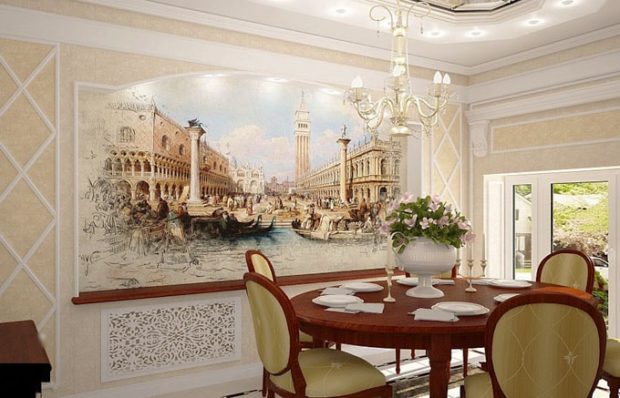
Fresco in the interior of various rooms
And again to the question of universality. Murals can be used in all rooms of the apartment - you just need to find the right type, and, of course, decide on the picture.
Fresco in the interior of the kitchen
It is best to place a fresco in the dining area. Modern and classic murals are resistant to various external factors, but expose them to increased risk and place them near car wash or slabs - this is barbarism.
Still lifes, floral arrangements, natural and urban landscapes, as well as images of cities are great for the kitchen. For small spaces, use frescoes with a perspective: a wheat or flower field, a winding street that goes into the distance, a forest path, a window with a view of the sea, etc.
A mural can occupy the entire wall around dining table, decorate only part of it or occupy two adjacent walls. Naturally, the picture should correspond to the chosen style of interior and color scheme.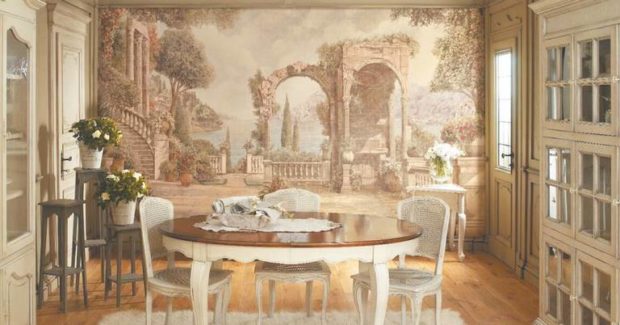
Fresco in the interior of the living room
A mural is the best way to emphasize the status of the main room. If possible, an entire wall can be highlighted under the image. Living room - the most suitable room to use a reproduction of a famous painting. True, such a solution will fit most successfully into classic interiors.
A win-win option is landscape. Which landscape, sea, mountain, forest or tropical, depends on the style of the room and your preferences. Landscapes are also good because, as a rule, they have a perspective that adds space and freedom to the room. For the living room combined with the kitchen, you can use still lifes. Consider the paintings of old masters, who very naturally depicted fruits, wine, game, flowers.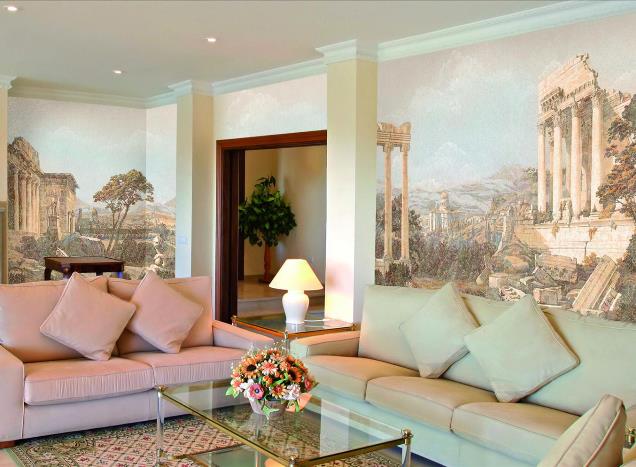
You might want to place a portrait of a famous person on the wall, for example, a historical figure of a certain era or a creative person who inspires you. Alternatively, you can use your portrait or image of a loved one.
Look good on the walls of the living room ornaments and abstractions. The ornament can be absolutely anything: such an image will unobtrusively bring the desired mood into the room. Abstraction unobtrusive can not be called. Here the emphasis will be either on lines or on color. The choice of image must be treated very carefully.
The high living room can be decorated with a ceiling mural. A cloud image is great.
Fresco in the bedroom interior
Often, frescoes in the bedroom are placed above the head the beds, but other options are allowed. For the relaxation room, images made in calm pastel colors are suitable. Beautiful natural landscapes, flowers, clouds, etc. will perfectly fit.Vivid shades and complex drawings with an abundance of details are undesirable to use, so portraits and detailed scenes should be abandoned.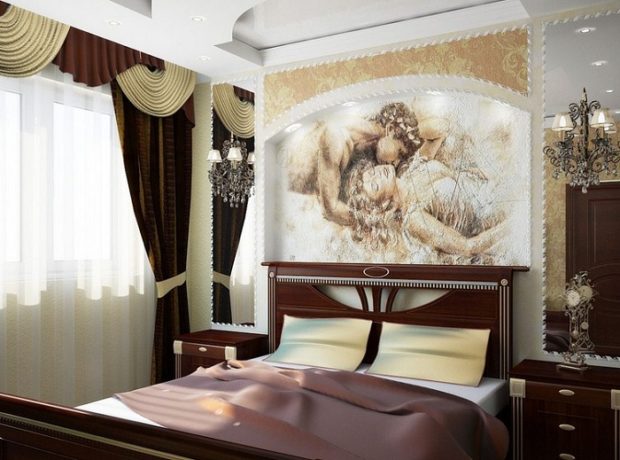
Fresco in the interior of the nursery
It is better to place the image near the bed, so that the baby, falling asleep, can look at the picture. It calms and simultaneously develops the imagination. As an image, it is better to take the plot from a fairy tale, a nice natural landscape, cartoon characters are also suitable. The picture should be moderately bright: the baby should not be bored looking at it, but the image should not irritate the nervous system.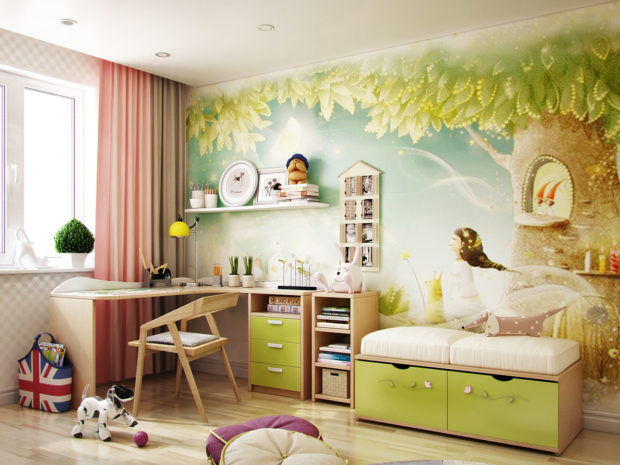
Fresco in the hallway interior
For hallways, which are usually dark small rooms, light murals are suitable. Long narrow corridor can be decorated with a colonnade overlooking the sea. An image of a window or balcony with a view from them is also suitable.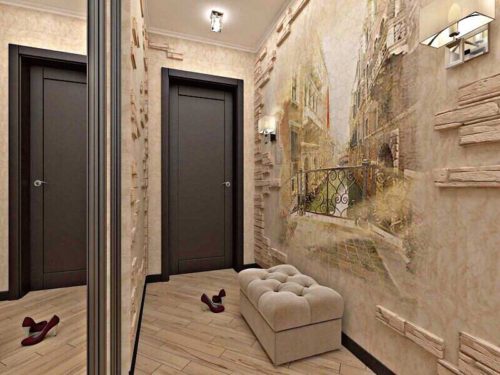
DIY mural
Create a freehand mural
This is an option for those who know how to draw at least a little, or who are ready to suffer a little and use a stencil, with which you can transfer almost any drawing to the wall. The sequence of actions is as follows:
- surface preparation. The old coating is removed, in the presence of irregularities use plaster or putty. Then the surface is primed and the finish layer is applied. putties or plaster. After re-priming, the wall is ready for drawing;
- At this stage, you should know exactly what size the fresco will be, and what will be depicted on it. The contours of the future image can be outlined with a pencil or masking tape;
- to create a picture best suited acrylic paints. Even if you are confident in your abilities, you must make a sketch of the future image in advance. So it will be clear whether all its details are arranged as intended. Designers recommend starting from the top of the fresco so as not to stain or spoil the finished parts. Some experts advise first to create large parts, and then draw small ones;

- if you don’t have the talent of an artist, then you should not be upset. Even in this case, you can create a mural with your own hands. Let it be a fashionable abstraction today. I do not want to criticize contemporary art, but, probably, anyone can draw a set of lines, shapes and color spots. For those who do not like abstraction, there is an option with stencil. There are stencils of tissue paper. It sticks to the wall, and when it has dried, you can start painting the finished contours. There are slate stencils. Take any image of the required format, draw the outline with a wide stylus and apply it to the wall. An image will be imprinted on it, however, in a mirror image, so keep this in mind;
- to age the image, you can apply craquelure to the dried paint. You can apply gilded or silver powder to slightly solidified paint - they will give the image the effect of antiquity;
- when the paints are dry, you can take a washcloth and carefully go through the entire mural, removing the excess. The image is varnished from above; several layers can be used.

We use the finished mural
Anyone who is far from creative, is afraid to spoil the interior or does not have enough time, can take the finished mural on a non-woven, self-adhesive or rigid basis.
More popular than others non-woven murals. Gluing them to the wall is easy:
- first you need to prepare the surface: remove the old coating, carefully align the wall, primer;
- before gluing it is better to close all doors and windows;
- use glue for non-woven wallpaper, apply it both to the back of the mural and to the wall;

- attach a mural to the wall and gently smooth its surface from top to bottom. You can use a soft roller or just a cloth. The main thing is that as a result the canvas sticks evenly and there are no air bubbles. To make it easier, you can advance, before sticking, mark on the wall the boundaries in which the canvas should be located;
- if the fresco consists of several fragments, they are glued alternately butt, making sure that all the details coincide clearly.

Fresco on self adhesive base mounted even easier. The base should be perfectly flat. On the wall, for convenience, use a pencil and level to mark the lines within which the drawing should be located. Start to remove the protective film and simultaneously press the mural against the wall, leveling its surface and getting rid of air bubbles. Better to start from the top left corner.
Rigid mural can be glued to the wall liquid nails. Other types of frescoes are more expensive and require a professional approach to installation, so in order not to spoil valuable jewelry, it is better to contact specialists.

